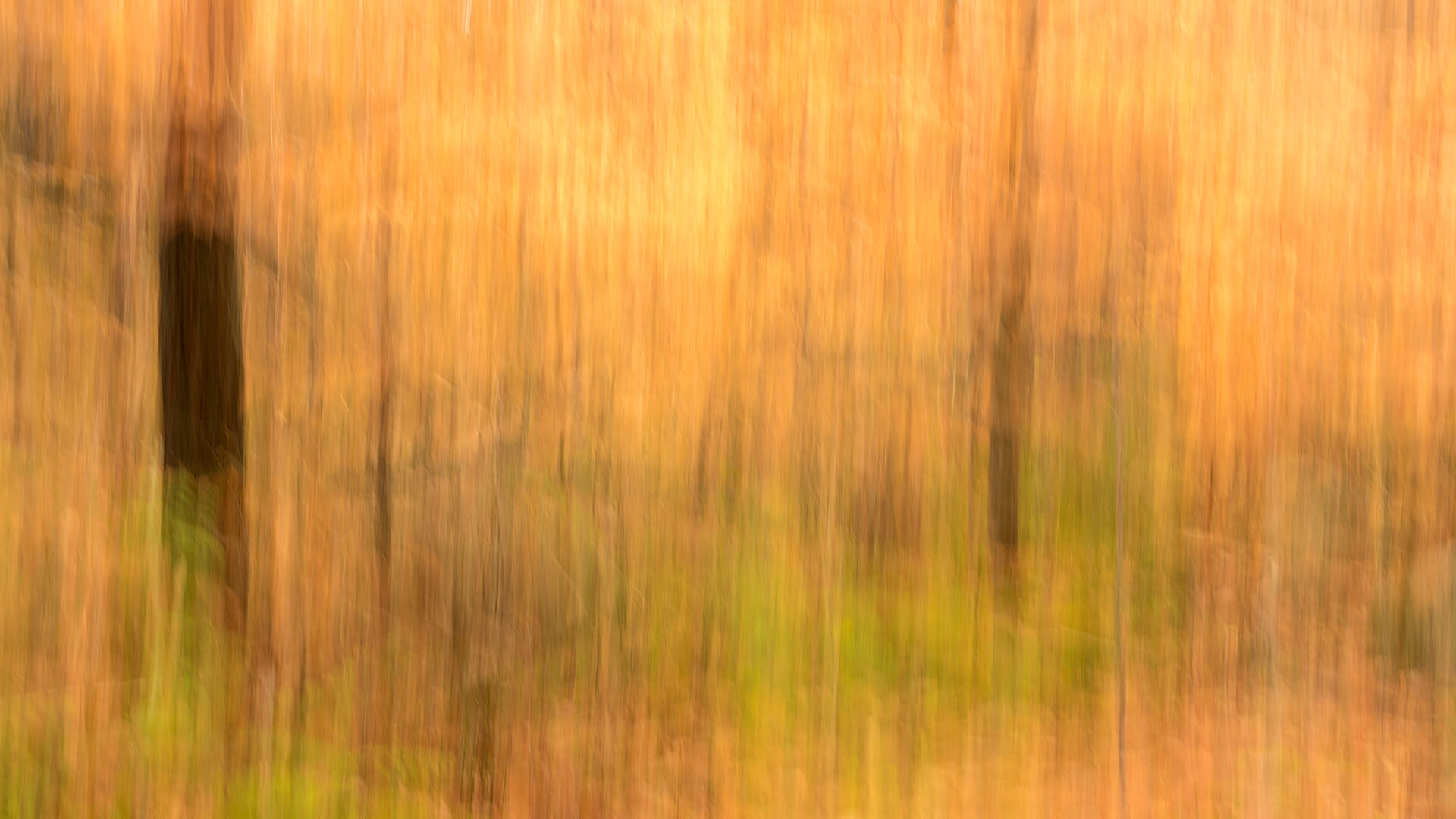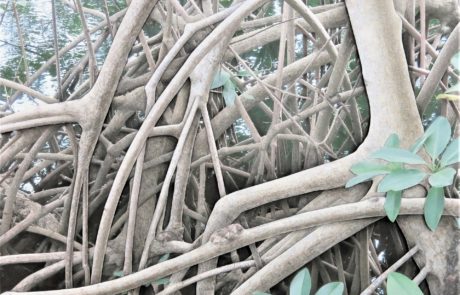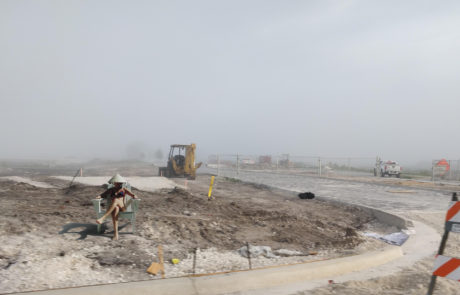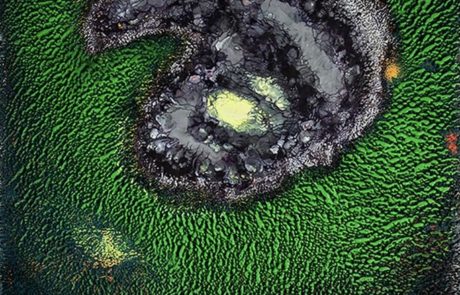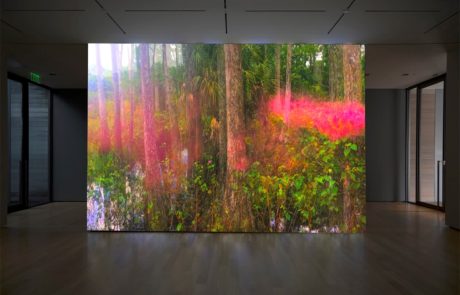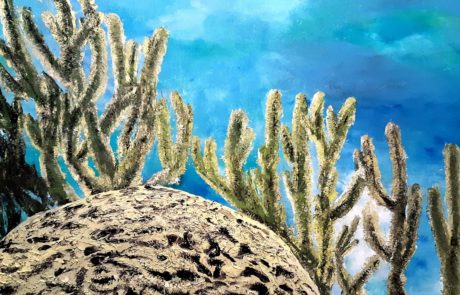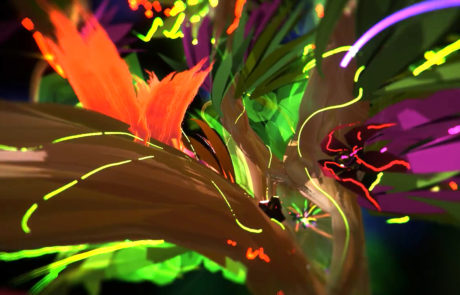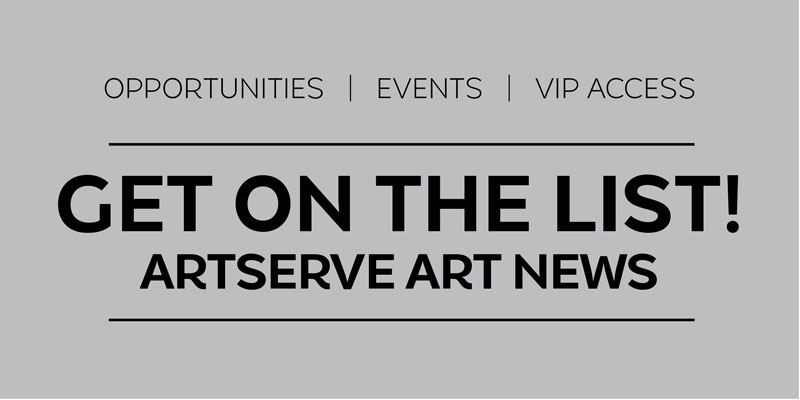
March 10th – April 26th, 2021
CHANGING LANDSCAPES
Art interventions for a Planet in Crisis
Curator
Sophie Bonet
Location
ArtServe, FORT LAUDERDALE
Opening Reception
Thursday, March 25th | 7pm – 9pm
Join us for the opening reception of ArtServe’s latest exhibition Changing Landscapes: Art Interventions for a Planet in Crisis featuring fine art projections, a dance performance, live music, and a cash bar.
*Visits and self-guided tour groups are limited to 15 people.
*Mask wearing is mandatory inside the space and 6ft distancing will be enforced.
ArtServe is operating under the Museum/Gallery Protocol for Broward County.
Environmental art is portrayed through a wide range of artistic practices. Ecologically and socially motivated works, such as “Green Art,” have been informed by climate crisis awareness, the protection and conservation of the environment, and the evolution of the ecological art movement.
This movement is truly interdisciplinary and includes artists who embrace ideas from science and philosophy, later translating those concepts through various art forms.
We invite you to join the movement of CHANGE, to reflect with optimism, and to flow in balance with nature, the environment, and the beings that inhabit it.

Artists
Alissa Christine, Founder of LUVRworldwide, is blending the boundaries of art, wellness, and technology with her pioneering 3D light sculpture paintings to be explored in XR. Her creations focus on positive change by inspiring inner growth, spirituality, and sustainability with love. In 2020, Alissa won First Place in 2 Live VR Painting Competitions.
Florida International Magazine called her a “Power Player – one of 100 individuals pushing Florida into the future.”
This Artwork, “Tree of Life” was painted in 3D Virtual Reality (VR), and Alissa records videos with a virtual camera inside the paintings for 2D and 360 viewing.
This piece intends to help the virtual explorer anchor intentions of abundance through the loving support of Mother Nature. We are all created to thrive on this nourishing planet, and the meditation for this piece provides cues to connect our souls to the Oneness of the infinite Universe.
Some of Alissa’s VR worlds can be experienced in VRchat in the Moksha VR 2020 Gallery, AltspaceVR, and in a VR healing session with the artist.
Alissa’s joy is sharing the magic of light, energy, and information, congruent with her wellness practices in the healing arts of over 11 years.
She develops VR meditative story-telling Worlds through her paintings, created to guide her audience toward states of spiritual elevation and mind expansion, where they truly #journeywithin. Sessions are immersive multi-sensory experiences including Reiki, aromatherapy, sound healing, and culinary pleasures.
Currently, her VR worlds have been featured in immersive platforms/events in WaveXR and a few recognized Universes of the Burning Man Metaverse.
Her most recent endeavor “cryptoLUVR”, is a Crypto Art Production & Curation entity, launched with the creation of CRYPTO ART MUSIC NFT VR Exhibit for #MiamiArtWeek2020.
Additional roles include Co-Curator of Art XRperience Exhibit at Miami VR Expo; Founding Member and Immersive XR Design Director of XR LABS Miami; Founding Educator with Magic Innovation Academy, focusing on VR/AR video and photography; Facilitator of Conceptual Design+ Courses at Miami Ad School.
Alissa is a professional multi-disciplinary Artist and Photographer participating/spearheading exhibits during Art Basel Miami and beyond, for over 15 years. In 2008 she authored and photographed her self-published, yearlong photo-a-day documentary book: “I love Miami 365”, soon to be activated in Augmented Reality (AR). Her photography portfolio includes some of Miami’s high-profile personalities, global healers, musicians, models, and artists, published internationally.
Alissa Christine is available for photoshoots, commissions for VR 360 music videos, XR experiences, Crypto Art Workshops and VR guided meditations for individuals, corporate groups, and events… in person, and virtually.
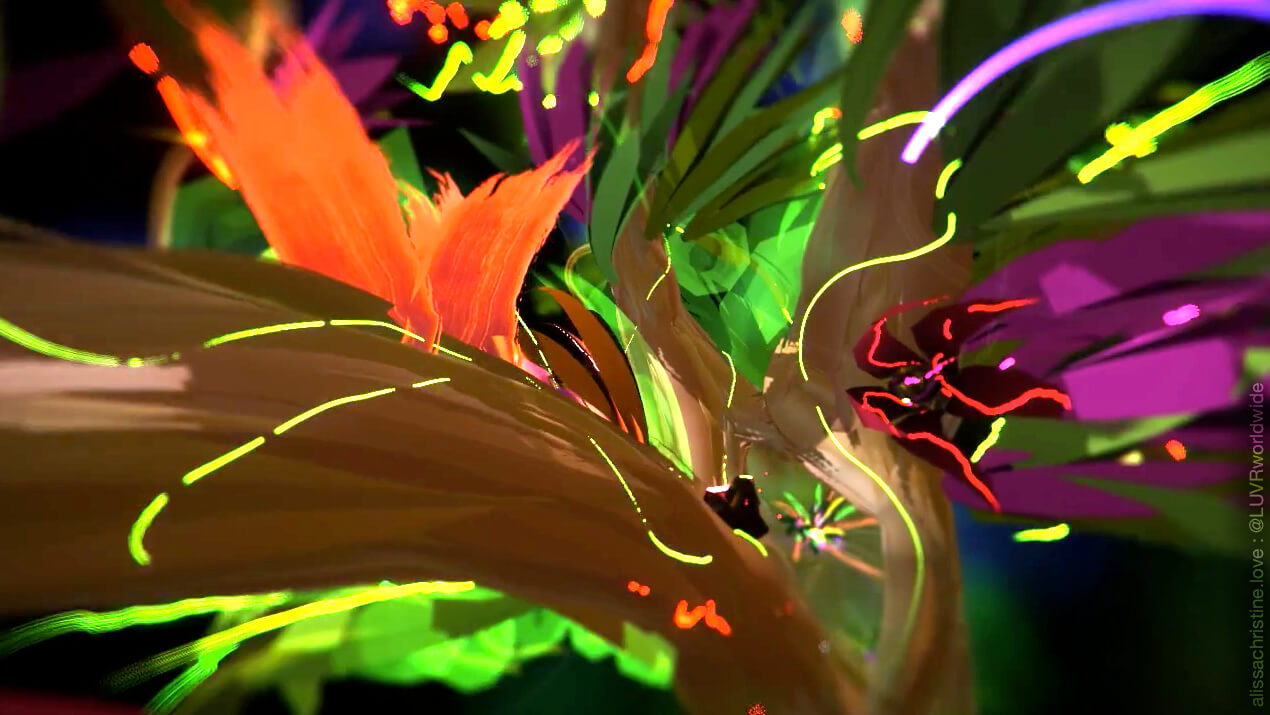
1982 I did a series of small paintings with one being the “celebration for our triumph.” My concerns back then were the proliferation of nukes, for many, the ominous technology of the day.
38 years on, the world’s grown apathetic to nukes due to the enlightenment of facts concerning many existing tech-derived consumptions. In some cases, the public was lied to about various consumer goods to further the profits of the manufacturers. Now I see the killing of one another with guns and bombs as a mild thing compared to the abuse and destructive use of planet-killing technologies.
Celebration 2020 suggests the fantasies of technology we are fed with optimism, intersect with their reality as they cross paths in the painting. On a computer monitor, I have a fantasy world badly outta control. Fury Road is a fine example of technology not delivering the utopia some promise.
The still-life painting of plastic trash surrounding the monitor like a noose is the quiet reality of many technologies choking the life out of the world. The strangulation of real plastic pollution caps off this bitch fest as I collected just a speck of trash and re-purposed it to fashion a frame as real as I could. So one more time, sarcastically with feeling, everybody, Celebrate our triumph!
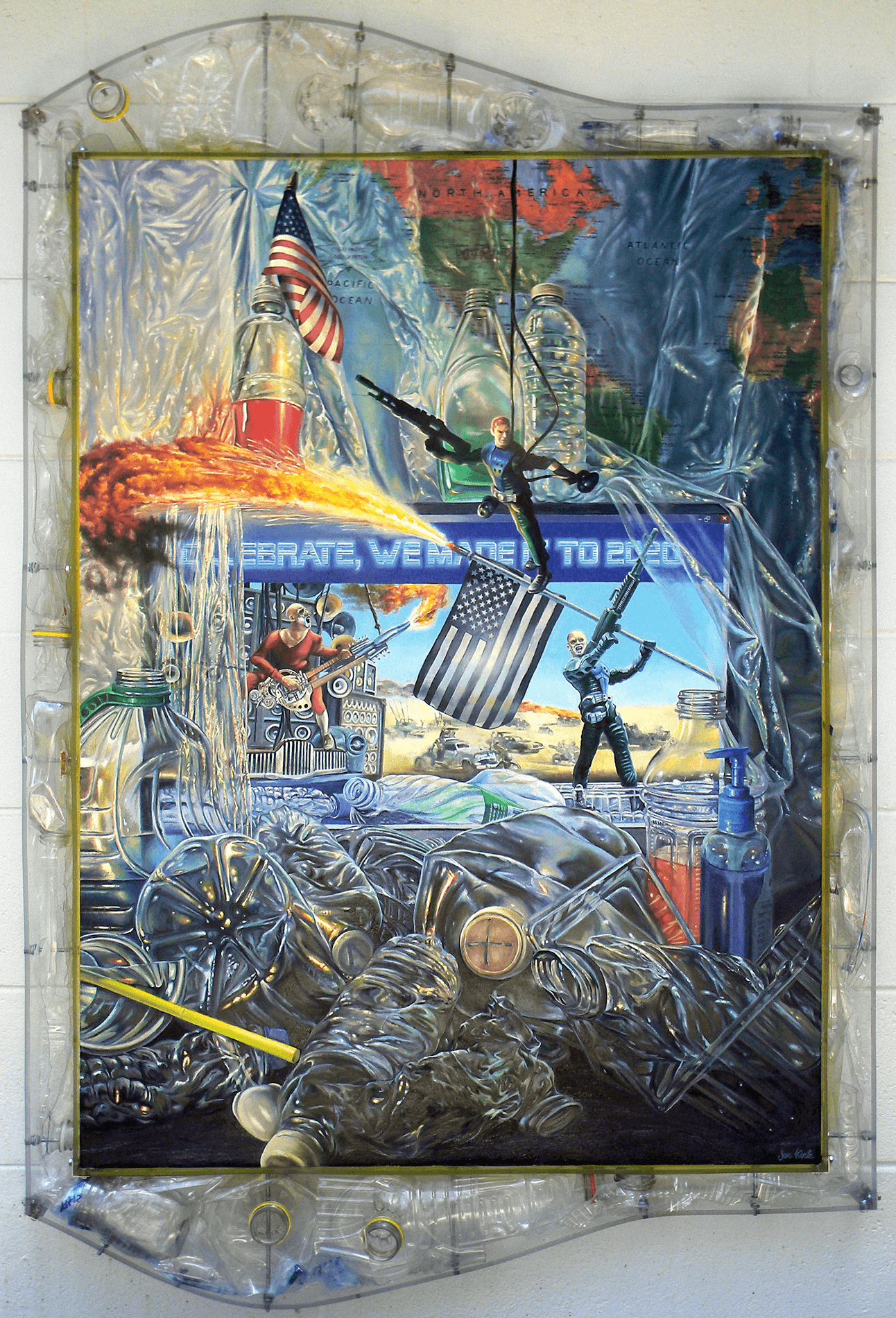
My commitment to the health of our planet has intensified as I understand more about the perils of climate change. This series was intended to highlight the beauty of South Florida’s natural landscape through my interpretation of the dynamics of space, light, and form. In nature, these relationships strike me when I see the gentle arch of a branch, a statuesque tree trunk, or a plant that spreads its leaves in fanciful directions. I am driven to compose artwork that celebrates our unique landscape and demonstrates how these natural elements relate to each other and their surroundings.
To fully express my vision, my work features a bas-relief / 3-D effect, lifting certain elements to emphasize the spatial dynamics of the composition. I intend to create work that invites the viewer into the scene, compelling them to consider the natural landscape in terms of shape, form, and space.
These pieces began with original photos, printed on drawing paper. The photos were then mounted in sections, with some pieces elevated to interpret the dynamics of the space. I then drew into the piece, using graphite, colored pencil, and charcoal, to highlight and accentuate light, shadow, spaces, and forms, until my vision was realized.
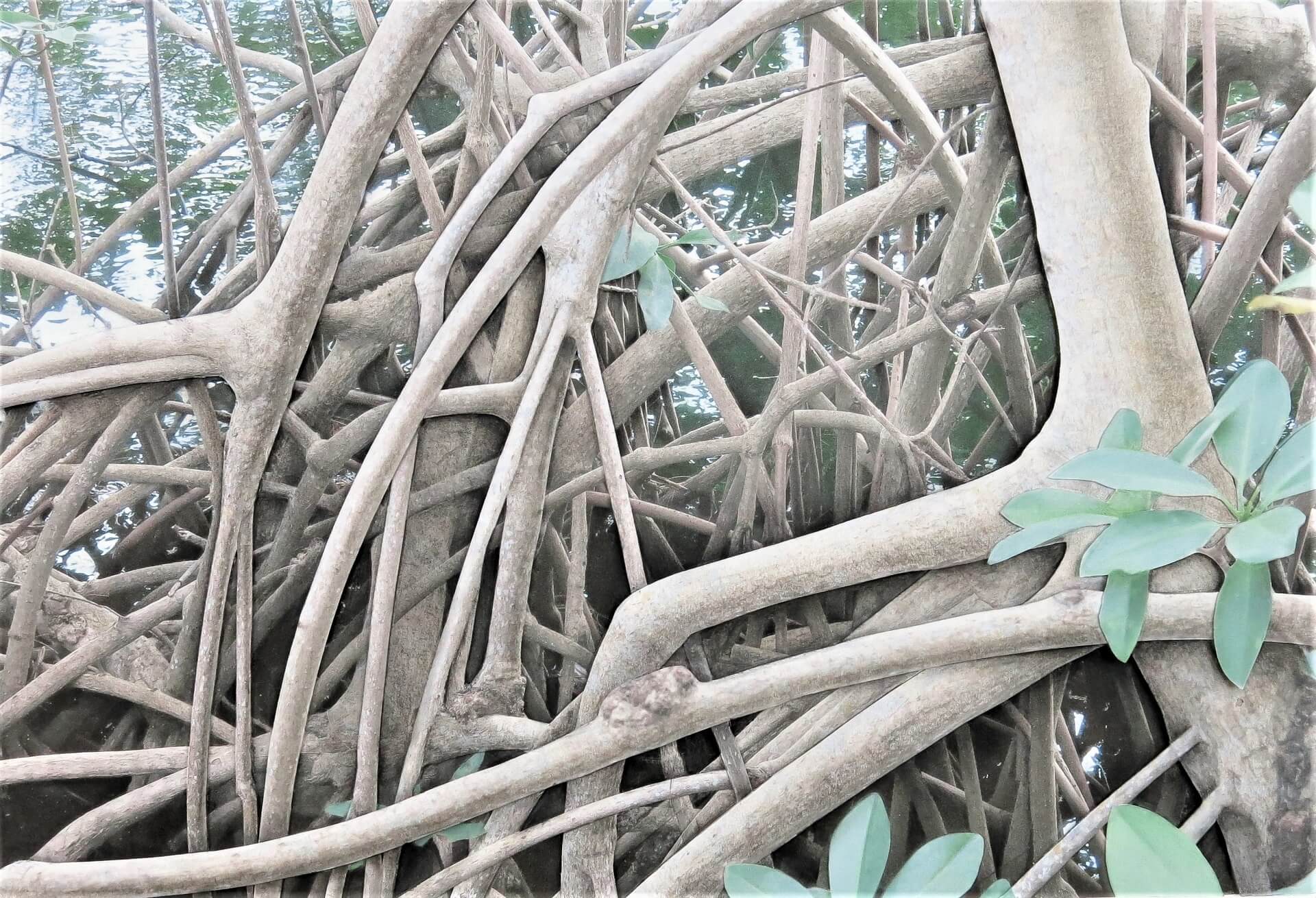
Ghost of a Ghost – The endangered ghost orchid, Dendrophylax lindenii, is Florida’s rarest orchid. It only grows in the State’s wet hammocks and swamps and is adapted to the seasonal rise and fall of water levels.
The disturbance of the natural hydrology due to man’s poorly implemented flood control measures have reduced its habitat. Worse, avid collectors have removed most of the wild orchids from our wetlands. Most of the collected orchids die within a year; thus, collectors kill what they most covet. Why must we strive to own the things we love? Take a photo, make an image, a memory, and leave it, with love, where it grows.
Turtle Tangle is a mixed media composition within an infinity lightbox. The piece is about the plight of sea turtles, and in particular the threats posed by plastics in the ocean. The plastics in the piece were collected on Florida beaches. There is the text about sea turtles, and the several issues putting them at risk of extinction, printed around the frame which is not easily visible in photographs; the interior of the piece is most successfully captured in a dark setting.
The piece is wired and ready to hang and includes a remote control that can change the LED lights from white to RGB light. The viewer is drawn into the piece as their reflection becomes a part of the imagery- prompting a personal reflection on one’s choices and how they affect the environment.
Sea turtles have cruised the world’s oceans for millennia. Of the seven species of sea turtle, five frequent Florida’s waters. All of these are endangered or threatened. Green turtles, a favorite food item of early sailors, were collected in such numbers that they were nearly extinct; however, conservation efforts have allowed the population to recover in recent years. Now, all sea turtles are protected under the Federal Endangered Species Act of 1973, and the Florida Marine Turtle Protection Act.
Many turtles lay their eggs on our beaches; every year scientists catalog roughly 100,000 nests along our shores. Most nests are Loggerheads and Greens; however, Leatherbacks, and Kemp-Ridley’s also lay on Florida’s beaches. Recently, scientists have discovered that climate change poses a new threat to the turtles: nest temperatures determine the babies’ sex, and rising temperatures are resulting in a disproportionate number of females. Other threats include oil spills, on-going predation by humans and invasive animals, fishing activities that result in accidental capture called “bycatch”, and human activities on the world’s beaches that impact nesting sites and limit nesting opportunities.
Among the several threats, plastics and microplastics are perhaps the greatest. Floating plastics are often ingested by turtles; necropsy results indicate that 100% of turtles are affected by microplastics. Ingested plastic persists in their digestive track and weakens the animals by preventing the absorption of nutrients. Baby turtles are particularly vulnerable; just a few pieces of plastic (+/- 15) can kill a juvenile. All the plastic items here (except the turtle) were collected on Florida’s beaches.
The consequences of our overconsumption are dire; we must act now to mitigate the plague of plastic we have poured into our oceans. We can make a difference. We are stewards of our environment which we share with all the world’s living things. We are not good neighbors when we destroy the habitat and homes of our fellow creatures; moreover, we are poisoning our environment.
Consider how you can reduce your waste, reuse items whenever possible, and recycle as much as possible. How sad would it be if plastic turtles are the only reminder left of this magnificent and gentle creature?
South Florida is home to two species of highly endangered butterflies, the Miami Blue and the Schaus Swallowtail .
The two factors most impacting the insects are the loss of habitat and the indiscriminate use of pesticides. Recent conservation efforts have released butterflies into areas of the Florida Keys to re-establish their populations.
The Atala or Coontie Hairstreak Butterfly was also endangered due to over-harvesting of its host plant, the Florida Coontie. However, in years, the butterfly has made a comeback as its host plant has come into popular landscape use.
What can you do? Plant some native larval and nectar species around your home. When necessary, use only environmentally safe pesticides.
- LAUDERDALE INTERNATIONAL AIRPORT MOSAIC CONCEPT
This project was inspired by the Nazca Lines of Peru. These lines, created 2000 years ago, are stylized graphic images of indigenous animals and symbols visible only from the air above the Nazca Plains.
The airport is one of the few venues offering an opportunity for arriving and departing airline passengers to see images from above. The mosaic will serve as a “Welcome Mat” for the Metropolitan area where most tourists to Greater Ft. Lauderdale and Broward County enter our area.
The imagery of the proposed mosaics depicts patterns reminiscent of the natural history of our beautiful State. Patterns are inspired by patchwork fabric art created by the Miccosukee and Seminole Tribes of Florida; imagery includes a selection of Florida State symbols, animals, and flowers.
The materials to be used to construct the mosaics are recycled glass and glow stones stabilized with a self-healing, permeable, organic binder, contained by a concrete curb.
These materials are recycled, low maintenance, at grade, and designed not to interfere with safe airport operations.
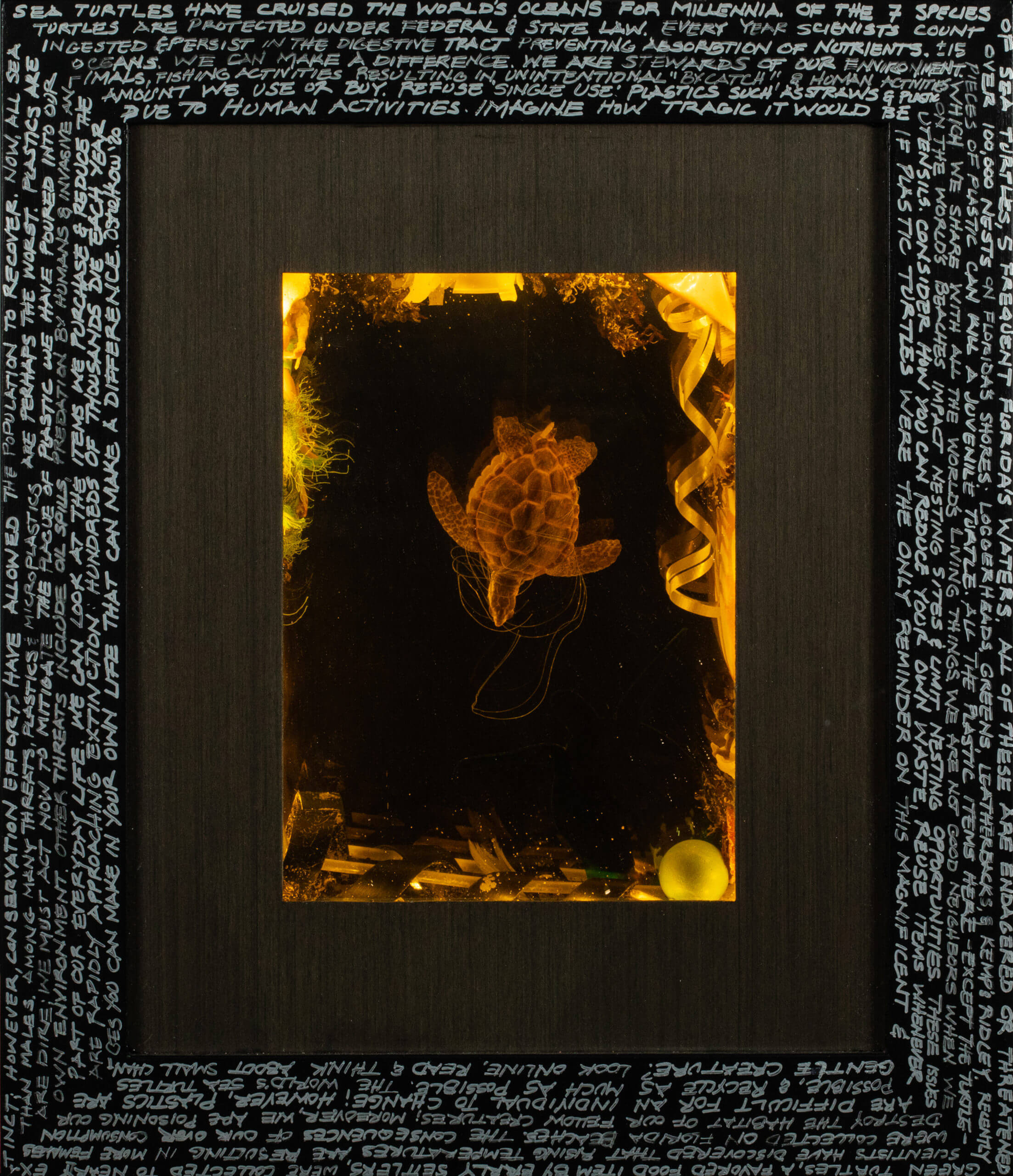
Although I could say I have been an artist most of my life, starting with paint by numbers at an early age, I have also experienced long periods where my involvement with art was from an appreciation or teaching standpoint.
In the past two years, however, I have been able to explore the use of acrylics on canvas and how color can be used to express my subject matter.
This exploration resulted in a more intense interest in nature, its beauty, and its relationship to our environment.
My use of color reflects what I see and feel during that experience.
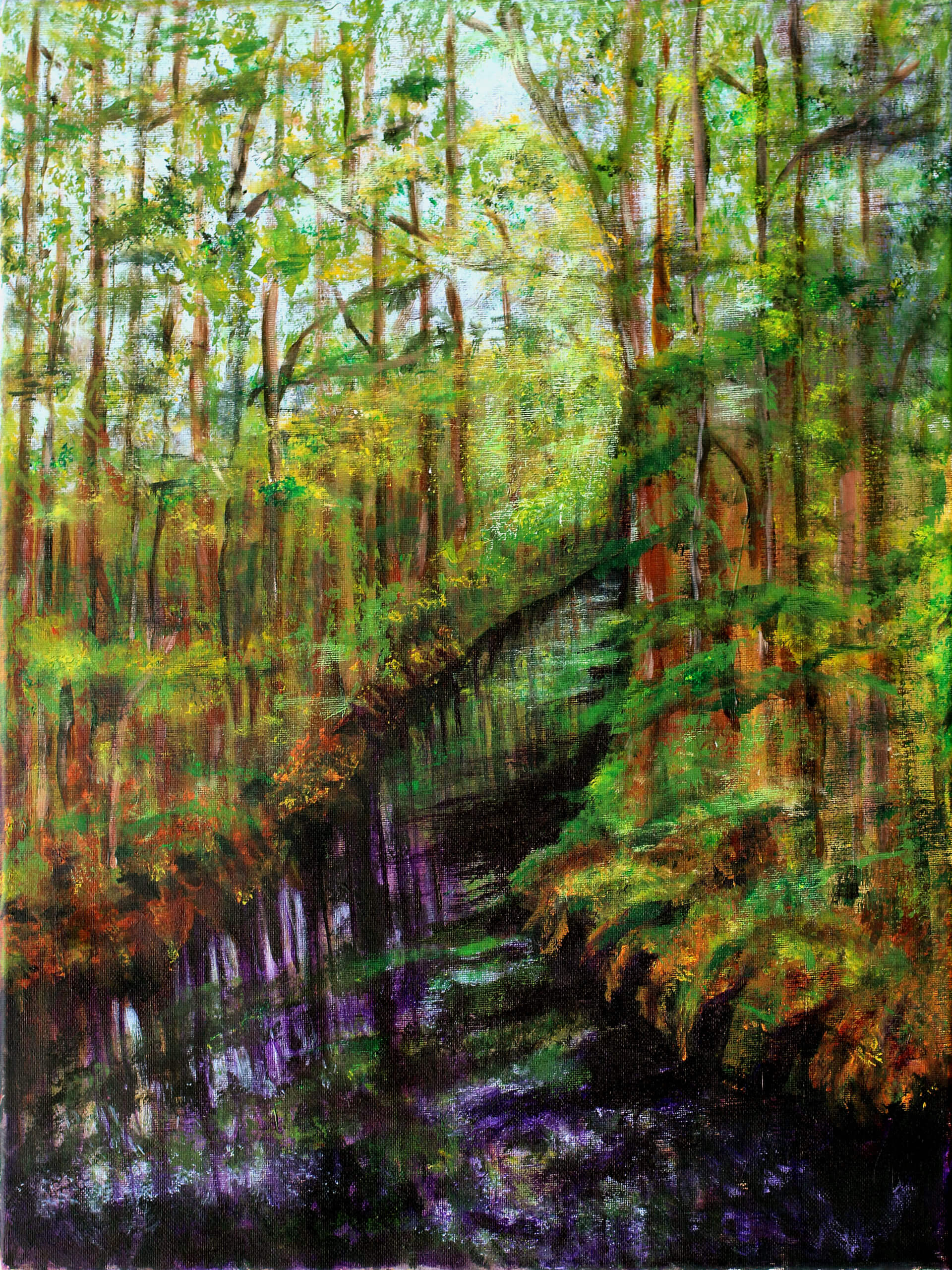
For over 40 years I have been engaged photographically with a small narrow island, affectionately known locally as Beer Can Island, on the west coast of Florida. As with many coastal islands, it has always been in a constant state of change due to storms and shifting currents.
However, during the past 10 years, I have witnessed its dramatic deterioration as the increasing level of Gulf waters invades deeper into the island drowning an ever-increasing number of trees and vegetation. The trees depicted in these photographs once proudly stood in the middle of the island.
I hope that these images serve to increase awareness and further reinforce the need to take definitive actions in dealing with the potentially devastating effects of climate change on the fragile Florida environment.
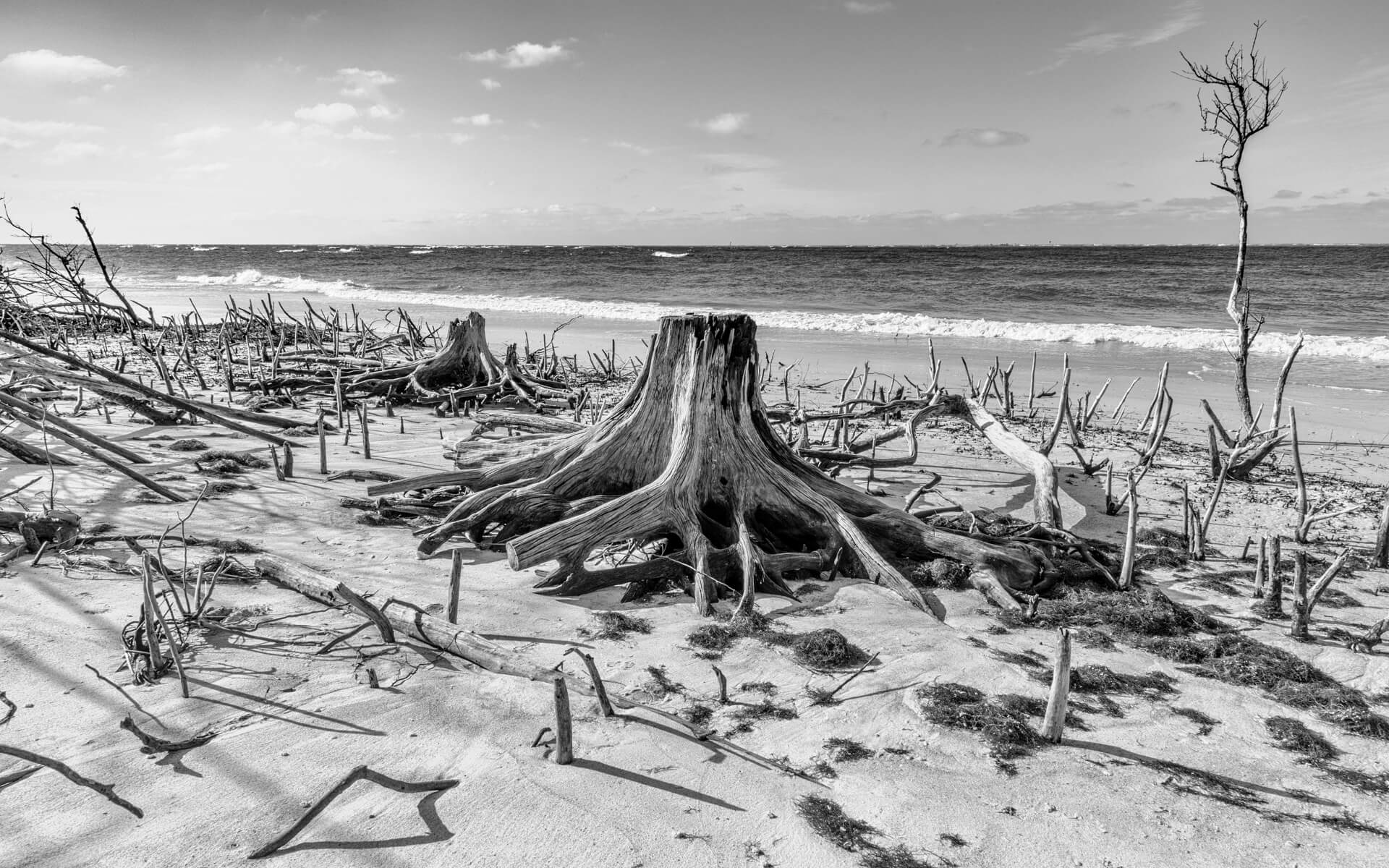
I create with a variety of media including oil, encaustic wax, and watercolors, and more recently, virtual and augmented reality. I approach the task of creating with curiosity and continuously strive to find new ways to apply and use my mediums or to learn entirely new ones.
I am currently working on creating art pieces to benefit the ocean rescue alliance project to bring awareness through visual storytelling and education using both augmented/ virtual reality, as well as works made in physical media such as encaustic wax, which has been my main medium for the last few years. This wax medium is perfect for the pieces I am creating for this project as I can achieve coral-like effects to create colorful reef scapes. I thought this project would be a great fit for the changing landscapes exhibition, as our oceans and reefs hang in a precarious balance and unless we restore their health, our oceans could look very different and far less diverse in the years to come!
I intend to create pieces in wax and mixed media that also have an augmented and/or virtual reality component to them so that there are multiple viewing experiences to be had.

My sculptures are figurative and reflect an aura of peace during a difficult time. Cradling clay in my hands, I felt a sense of strength. Molded clay was painted and combined with well-worn materials and tree debris. The sculptures became my connection to the Universe.
Sometimes I would go for walks, focusing on the uphill battle I was climbing inside my head. Outside on the street, debris from trees and discarded objects would appear as visions of a higher power reaching out.
One evening, a group of us happened by a dumpster and saw a wooden ironing board. I became the new owner of this antique, which was made before 1940. It resembled the silhouette of a man in a hooded frock, like St. Francis of Assisi. He is the patron saint of ecologists for he loved animals and nature. With clay, a varnished tree limb, and a ready-made twig, the sculpture Old Man with Bird came to be.
I later spotted a perfectly shaped palm frond that resembled the torso of a woman. The imaginary figure had “wings”, like a celestial being, and became The Guardian Angel.
The image of the Sacred Heart appeared to me in the bark of a palm tree that had fallen onto the sidewalk. I took the piece on the bus to my studio, cleaned and varnished it, then created a red clay figure in a crouched position and placed it in the heart of the sculpture. I named the piece, You Are Protected.
The Old Man with Bass is my version of The Old Guitarist , the painting of a humble musician Picasso created during his “Blue Period”. The instrument in my sculpture came from discarded wood and metal left in the middle of the road. The figure is clay and a palm frond.
I am grateful for the connection to the Earth and beyond that these pieces have given me. Mother Nature is truly majestic. Perhaps the art can shed light on the importance of taking care of our environment. Our children and wildlife are depending on us.

Spring in Suburbia – a photo series honors the beauty within our surroundings while suggesting a feeling of displacement.
What appears to be indifference, peace, or contentment conveys the lack of belonging. This series illustrates being present while clearing negative blockages like isolation, anxiety, or sadness towards the suburban lifestyle.
Just as landscapes remain dynamic due to societal growth and natural processes, the artist explores how inner landscapes go through a similar metamorphosis and excavation.
The repetition of the same character or mindset becomes apparent. Self-portraiture acts as a medium for reflection, a lens for addressing old patterns. As values get re-examined the varied landscapes act as stages for identity. Using a metaphorical approach, the artist questions how changes to environmental elements function as anchors for personal and social identity, fundamental for understanding connections to inner landscapes.
Stepping outside of your comfort zone, going places real or imagined, and being present has led me to incredible personal growth and a fresh perspective on life.
I am an artist, Florida state-certified teacher, and creative life coach guiding young adults through personal journeys of self-discovery and, often, the discovery of their creative talents. My passion to create innovative mixed-media art and photography – and to help others bring out their inner artists – has led me to teach in NYC and South Florida schools and community spaces for 18 years.
Whether finding my inner-expression in art or helping my students do the same, I always try to offer a positive, energetic perspective.
I’ve been pursuing my artistic muse since early-childhood. Later in life, I discovered that artistic expression could be a tool to heal. In college, I used art to work through the anger and pain of my Mom’s death. Later on, after the difficult birth of my daughter, I used art to sort through the emotional challenges and creative shutdown that followed. It was then that I was affected most profoundly by its power to heal. And it was then that I started teaching others how art could be used for healing in stressful situations. And how it can promote inner happiness and well-being.
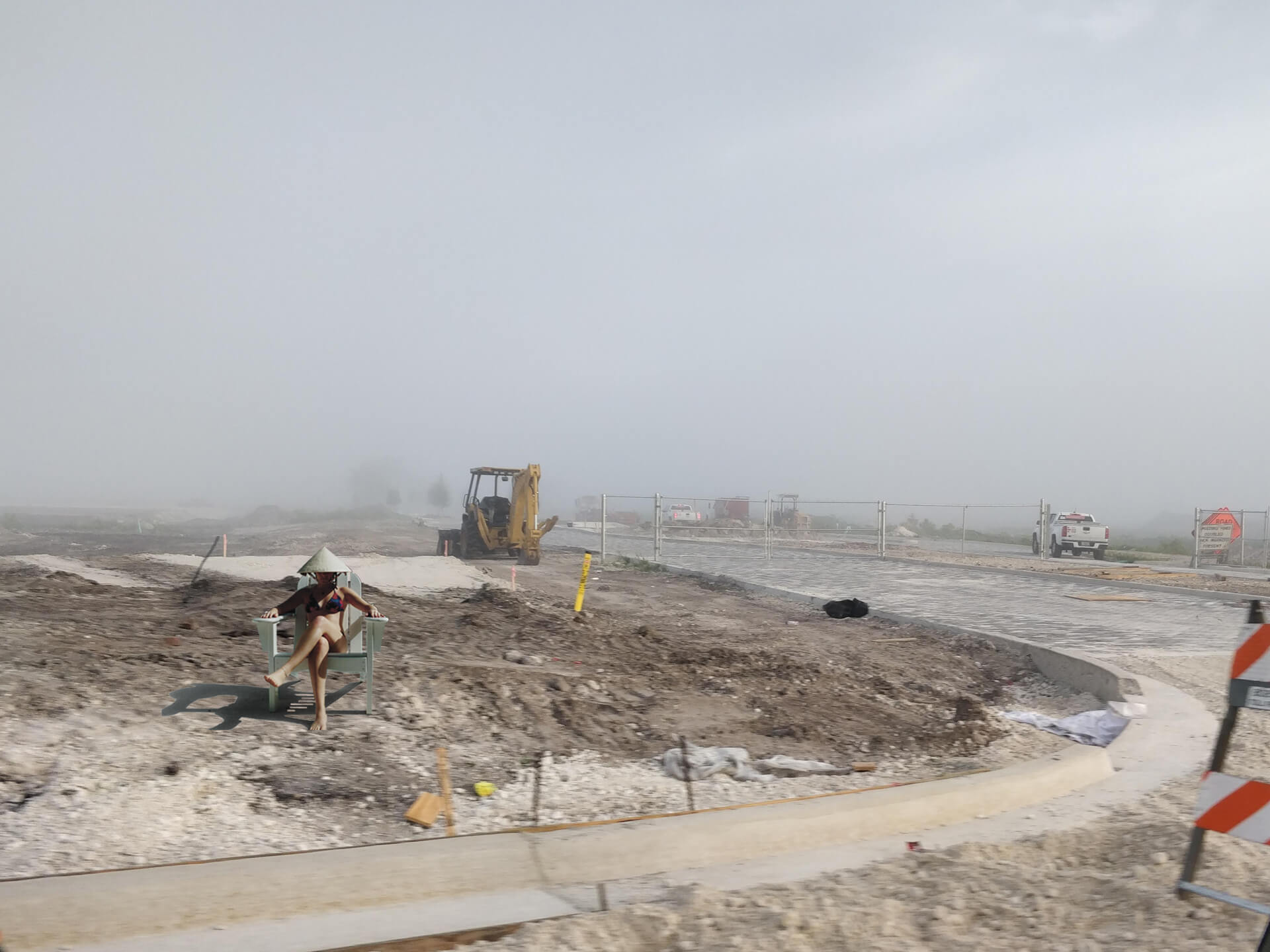
Nature’s incredible allure immersed in man’s transgressions is the inspiration for my current paintings. The subjects are created inherently while being skewed by technology and subtle changes that affect our daily lives.
The finished surface on my canvas is layered and glazed until the desired saturation point is reached to produce a rich, multilayered canvas.
You may say the subjects are Pixelated. I see them as Fractured. Look closely for the streams of water running through the saturated landscapes now broken by divisions in nature, technology, and values.
We are Being Manipulated through the media, computers, robotics, and environmental changes. My paintings document these changes.
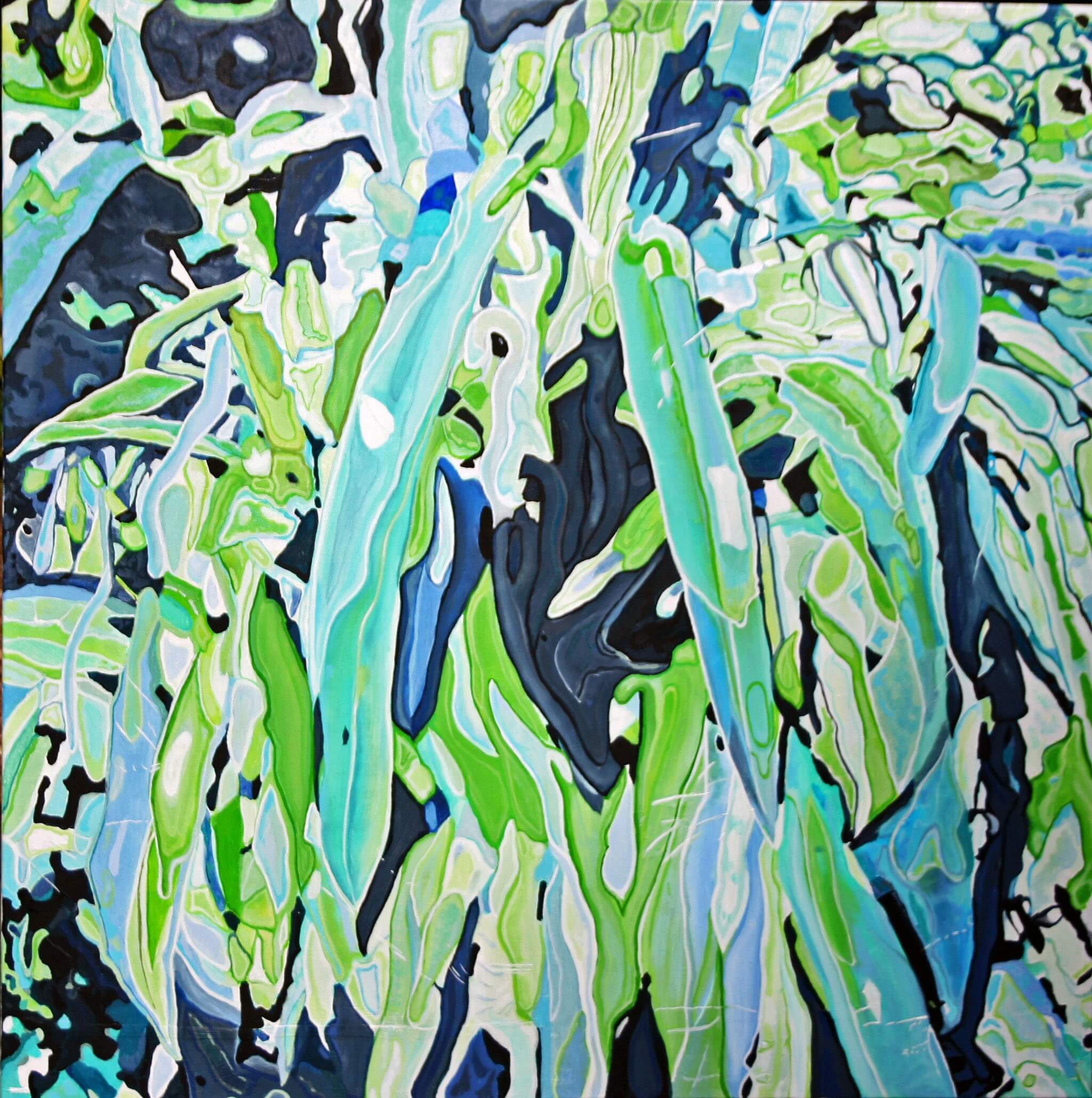
I have always loved birds. My father was an Air Force Fighter pilot. I was always looking up!
Birds are interesting creatures that grace our skies and protect our environment.
As an artist, I love their lines when they are still and when flying.
Some of these paintings are of wild birds and some rare birds in a sanctuary at Flamingo Gardens. I also live on the Ocean and admire the sea birds.
Many of my paintings are depicting Pelicans. These are very interesting birds in that many are self-sacrificing. A mother pelican will bite her skin to let her Babies suck her blood for food. The English military used the pelican as a symbol for blood donations during the Great War( WWI).
These pelicans were photographed at the Flamingo Gardens Birds Sanctuary in Davie, FL. These birds can no longer survive in the wild. They live their lives here in the sanctuary where they are fed and cared for by a staff of employees.
Like a flying dinosaur straight out of Jurassic Park, the Brown Pelican (Pelecanus occidentalis) has prehistoric antecedents going back 30 million years.
Pelicans have a rough life. Many get injured because they hang around fishing piers with hooks and lines. They dive into the ocean for their food which eventually leaves many blind.
They are selfless birds. Mother pelicans will bite their skin so their babies can suckle their blood when they don’t have enough food.
I am the daughter of an Air Force fighter pilot raised living around the world. When I was very young my mother would point to the sky and tell me that was my father. I have loved birds ever since. These social birds are often seen in large groups, variously known as a squadron, scoop, pouch, pod. My father would later tell me that the pilots fly in formation like the birds.
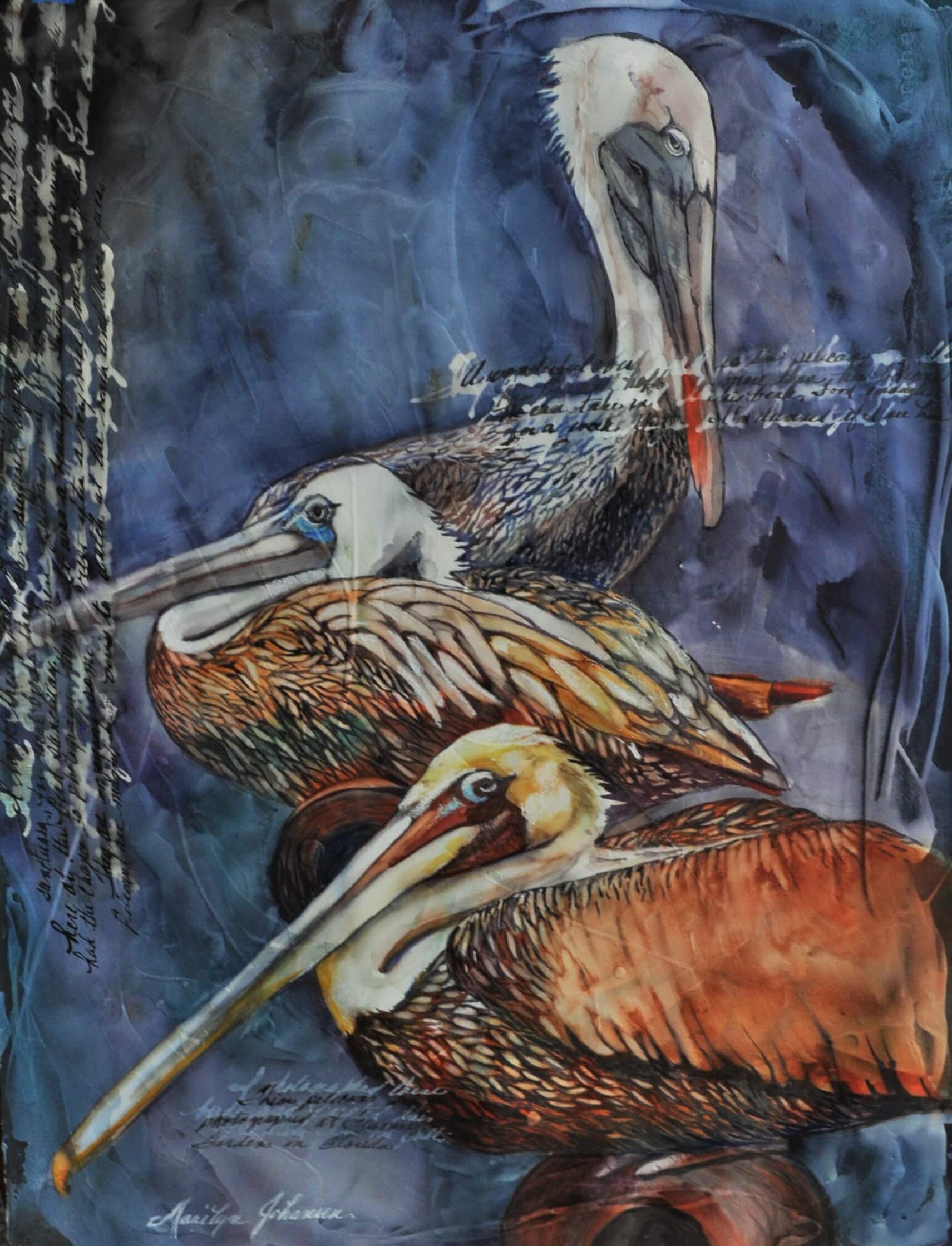
As a photographer and world traveler, most of Paul McDermott’s work is embedded in nature. The world’s natural environment is decreasing at an alarming rate.
This is mostly by the fault of the human species. Our exponential growth in population, industry, and technology has come with the exponential use of our natural resources. It is our responsibility, now more than ever, to act as stewards of the planet and actively put to reduce and reverse our impact on the environment.
Change only happens through awareness. Paul has taken it upon himself to showcase the beauty of nature throughout the world. Putting attention towards the environment’s profound beauty leads to the passion that creates action.
Action preserves and protects the environment, facilitating ecological coexistence on this planet. With a proactive approach to ecological integration, we can implement win-win projects that enable all life on this planet to thrive.
Paul’s collection of images exhibits profound moments from around the world that bring viewers into the experience as if they were there themselves. The curatorial tour of interactions with wildlife and poignant landscapes enacts a deep love for and connection to nature.
Exploring nature’s decomposition and its connection to pollution have heavily influenced my sculptural works. The over-production of plastic goods has an immeasurably negative influence on ocean life, due to the unquantifiable amounts of plastic waste found in the oceans today.
The production of these materials goes hand in hand with rising carbon emissions, shifting the climate, and adding to the demise of coral reefs and their inhabitants. I visually address the issues of both pollution and coral decomposition.
The use of intense color and contrasted forms created from the discarded plastics compounding these problems addresses both the issue of wasteful overproduction and the decomposition of our coral reefs.
Fort Lauderdale artist Mandel Vixamar presents an ever-evolving style encompassing a variety of social, political, and historically based themes.
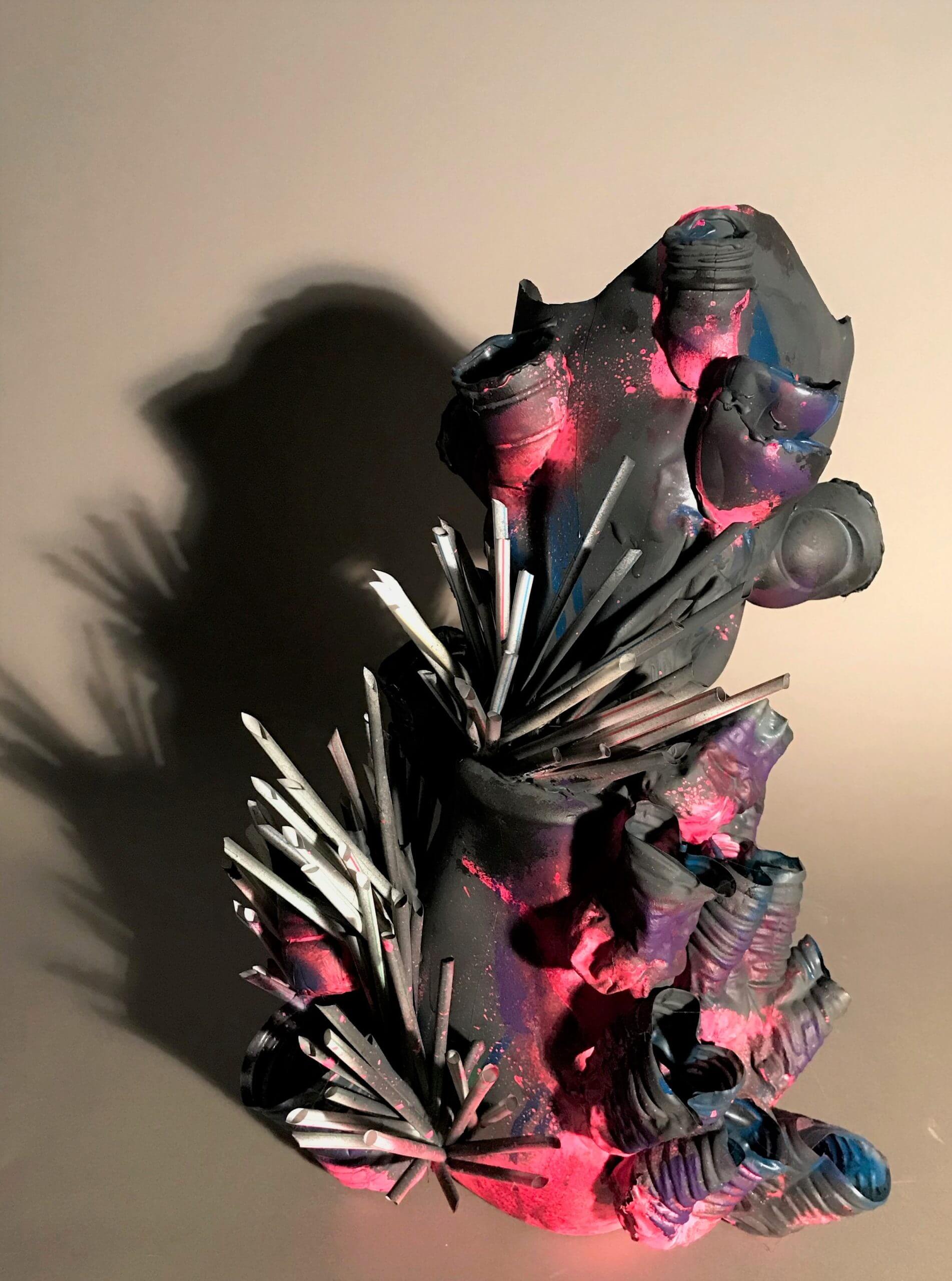
Gradients; Rising Tides: 2019
Gradients is an installation of 10 paintings that visualize sea-level rise specific to the location of Georgia’s coastline. I painted these when I did an artist’s residency in Savannah, Georgia. Each painting represents a decade from 1930 to 2020. Studying the data from NOAA’s tidal gauge in Fort Pulaski, I wanted a visual representation of exactly how much and how quickly the sea level is rising. The tidal gauge measures sea level every six minutes since 1935. The bright pink line symbolizes the measurements as the rainbow gradients represent land. As the paintings slowly become less saturated with time, I was thinking about the loss of land, ecosystems, and vibrancy our world is facing in the Anthropocene.
To see the Change of Color: 2019
To See the Change of Color was an installation of 100 paintings to visualize how little had been mapped of the seafloor in 2019. Each painting represents 1% of the earth’s surface. This is a small section of the original installation that was created in 2019. As 29 white paintings represent dry land, 71 blue paintings represent oceanic surfaces.
Less than 10% of the seafloor had been mapped in high definition. leaving over 60% of our shared planet unexplored. The shiny blue panels represent the glittering surfaces of this planet that we know little of what happens below. The brightly colored paintings represent the multi-sonar mapping that has been done in certain places to uncover the deep blue unknown.
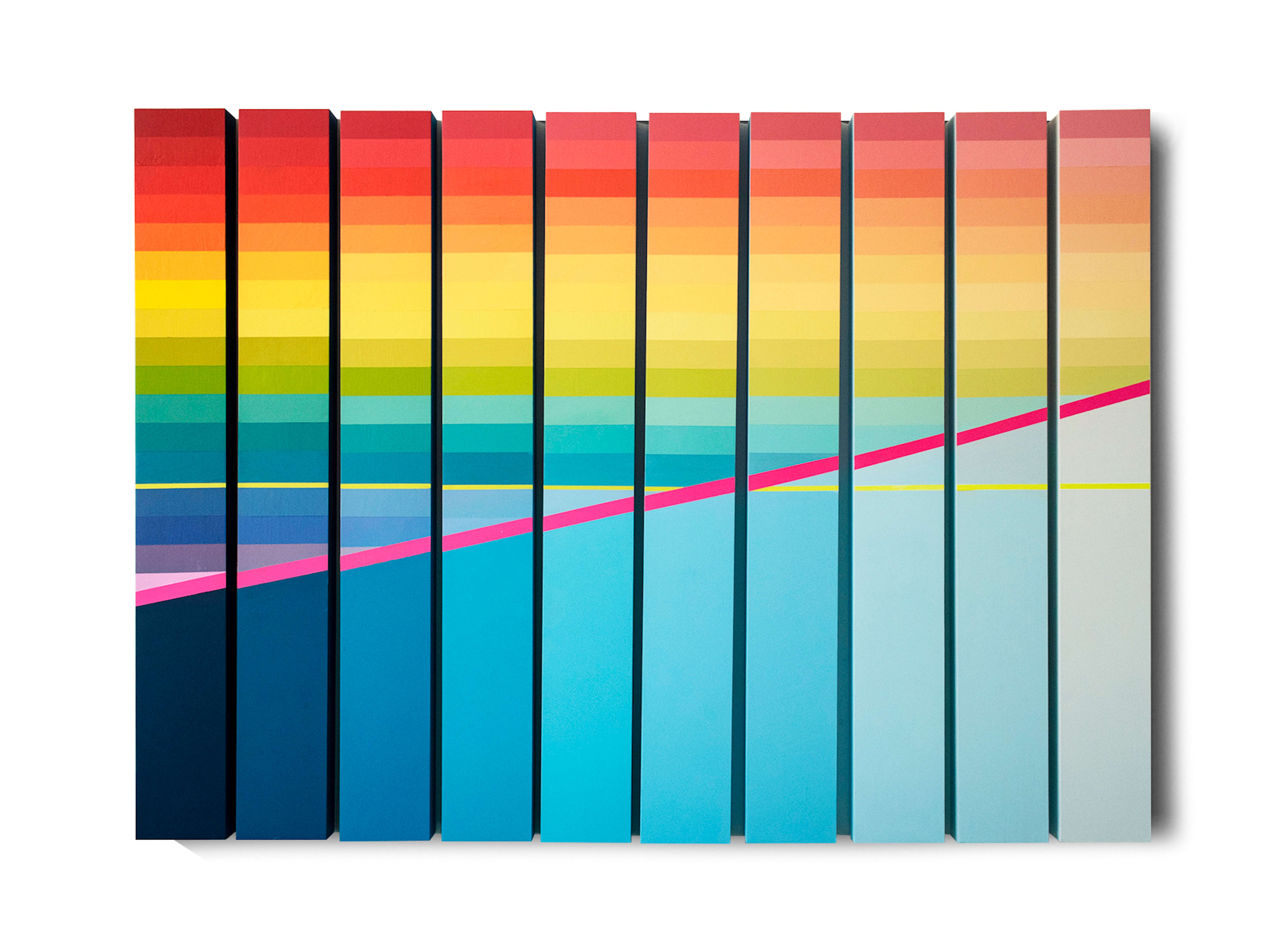
Super Natural
Immersive Video Installation
The core of my work is about “connection”; the innate connection to the self, each other, and all other life forms.
Since the months of the pandemic, and being quarantined indoors, I would escape to the forests, lakes, and ocean where I am most at home.
During this time, I have created my Super Natural Video Installation. Fusing the natural world with my inner world, I created the film for the Super Natural Series entirely on location working with the elements of wind and the natural light, as well as, working with eco-friendly materials.
The fog of color is created in each set of locations. As the color lifts and fades away, I am reminded of the impermanence of life and the healing power that springs forth with change.

Sibel Kocabasi is a multidisciplinary visual artist, working in painting, staged photography, and installations. Her art addresses contemporary social concerns: from the deteriorating natural environment, migration, violence against women, across cultures, including the suppression of female identity and the recent awakening of feminine power and confidence. In her artworks, she utilizes diverse media: such as traditional rugs, found objects, emergency survival blankets, and fibers.
MERGING, 2021
The gold and silver survival emergency foil blankets installation is intended to bring attention to climate refugees’ conditions around the world.
Multiple blankets draw a personal connection to the multitudes of climate refugees, it is symbolic of the potential for togetherness and survival.
Portrait of Ocean Life / Ocean Survival
“Portrait of Ocean Life / Ocean Survival” is a transformational immersive installation that explodes conceptual impressions of “pictorial space” to encompass the physical gallery walls, floors, and air. Integrating traditional and non-traditional media actively engages the viewer in visual, sensory, corporeal, and cerebral levels of cognitive reflection about our surrounding ocean environment.
My artistic intention is to create a viscerally engaging multimedia environment that powerfully addresses the integral presence of toxic pollution in our living, breathing oceans.
Various elements carefully orchestrated together include 2 original oil with graphite paintings on canvas of gentle, dream-like, abstract oceans, as seen from above; a wide spectrum of draped placed cloth fabric pieces that symbolize the ocean textures, structures, and movements; cut plastic, cellophane, foil, paper, and cardboard pieces “collaged” with the flowing cloth, represent the thriving threat of ocean pollution; and a collection lost human “belongings” and/or the detritus of human migration by sea, left to float ashore.
The original abstract paintings are based on the natural flow and form of the living ocean. Both oil and graphite images reveal gentle, embracing ocean water slide and glide, graceful liquid energy, and complex natural beauty.
The “Cloth Ocean” on the floor and walls induce a physical sensation of tidal movement in ocean water. Walking through the cloth sea to view wall art is a visceral and visual experience, surrounding the viewer and facilitated by clear pathways through the ocean, to gain close observational access to the paintings.
The silent historical human presence of ocean migration is expressed and emphasized by the real “belongings” mixed in the cloth sea, such as identifiable articles of clothing in various sizes, including children’s, old pairs of glasses, shoes, and more.
I paint loosely gestural and energized strokes of blues, greens, whites, and grays accented by deeper contrasting colors to convey ocean depth and perceptible moving presence. These paintings contrast sharply with the factual presence of actual polluting plastics and foreign elements in the seas. Human sea migration is suggested and displayed as another real and sadly preventable trait of ocean life, unfortunately, overlooked.
Fabrics and textiles included in the installation are denim, brocade, organic cotton, cotton sateen, sequins stretch fabric, antique lace, hand-crocheted linen, and commercially printed cotton blends among others. Genuine cut glass crystals are added to reflect light from the cloth ocean surface, as pulsing sunlight reflects on rippling living oceans.
This entire Immersive Multimedia Installation is created “in situ,” specifically made for the Artserve Gallery space.
As Florida residents, we are all deeply connected to the oceans as dominant beloved elements of our authentic natural environment. Intensified and augmented attention to ocean conservation is critical to ongoing human and ecological health.
Butoh Dance by Pinar Isik, Video by Bulent Ince / Graphixel.com, Music by Kai Engel “Moonlight Reprise” / FMA
“My movements have a sense of connection and communication with the earth. Speaking to nature with emotion and passion can unlock an awareness of the environment.”
Pınar Işık Sinka was born in Izmir, Turkey. She is a multidisciplinary artist who works in the field of Fine Arts and Performance Art in an Avant-Garde base and founder of PI Art Butoh Dance Company. Sinka is a visual artist, curator, Butoh dancer, choreographer.
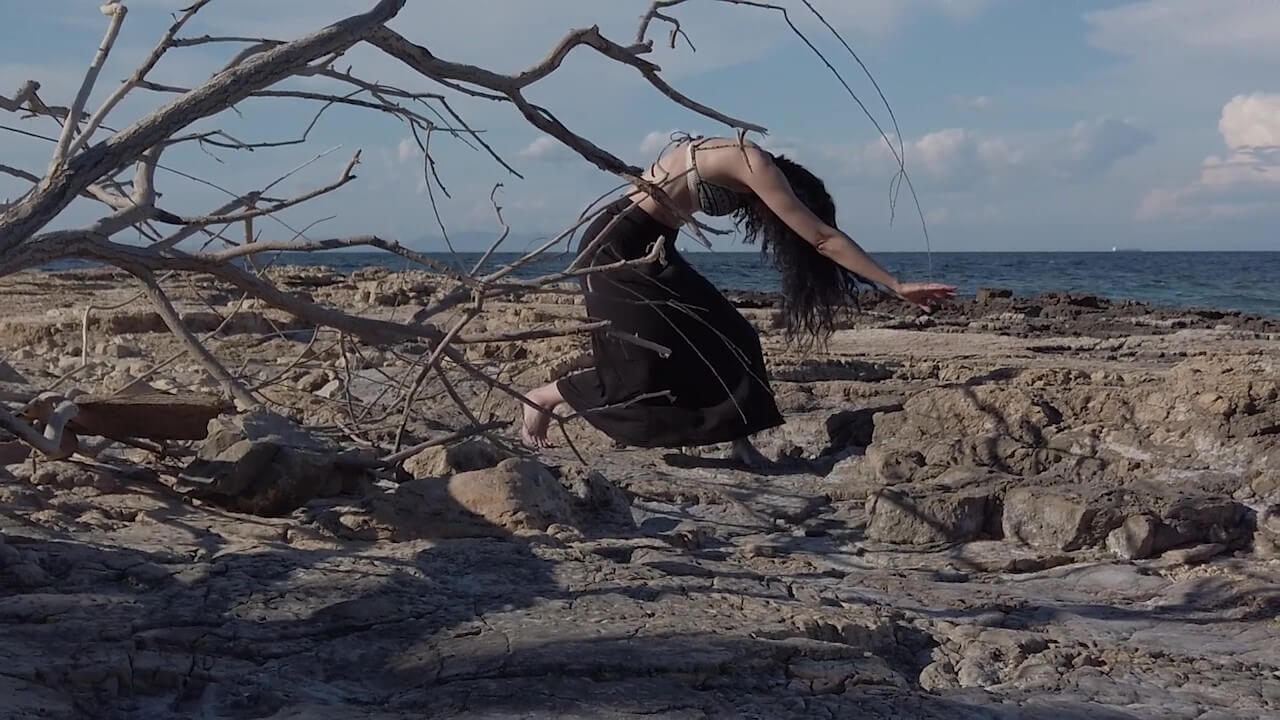
One Thousand Ocean Memories is a community-based project facilitated by South Florida artist Lizzy Taber in collaboration with ArtServe. Taber’s work explores many aspects of the ocean, both emotional and scientific.
The 1,000 Ocean Memories project is an ongoing collaborative artwork that requires community participation. It explores our collective relationship with the ocean alongside how our memories of the sea shape our view of the ever-changing natural world.
ALL are invited to submit! This project is based on the idea that with modern technology, on average a person who visits the coast – not only has a memory with it but a physical souvenir – a photo.
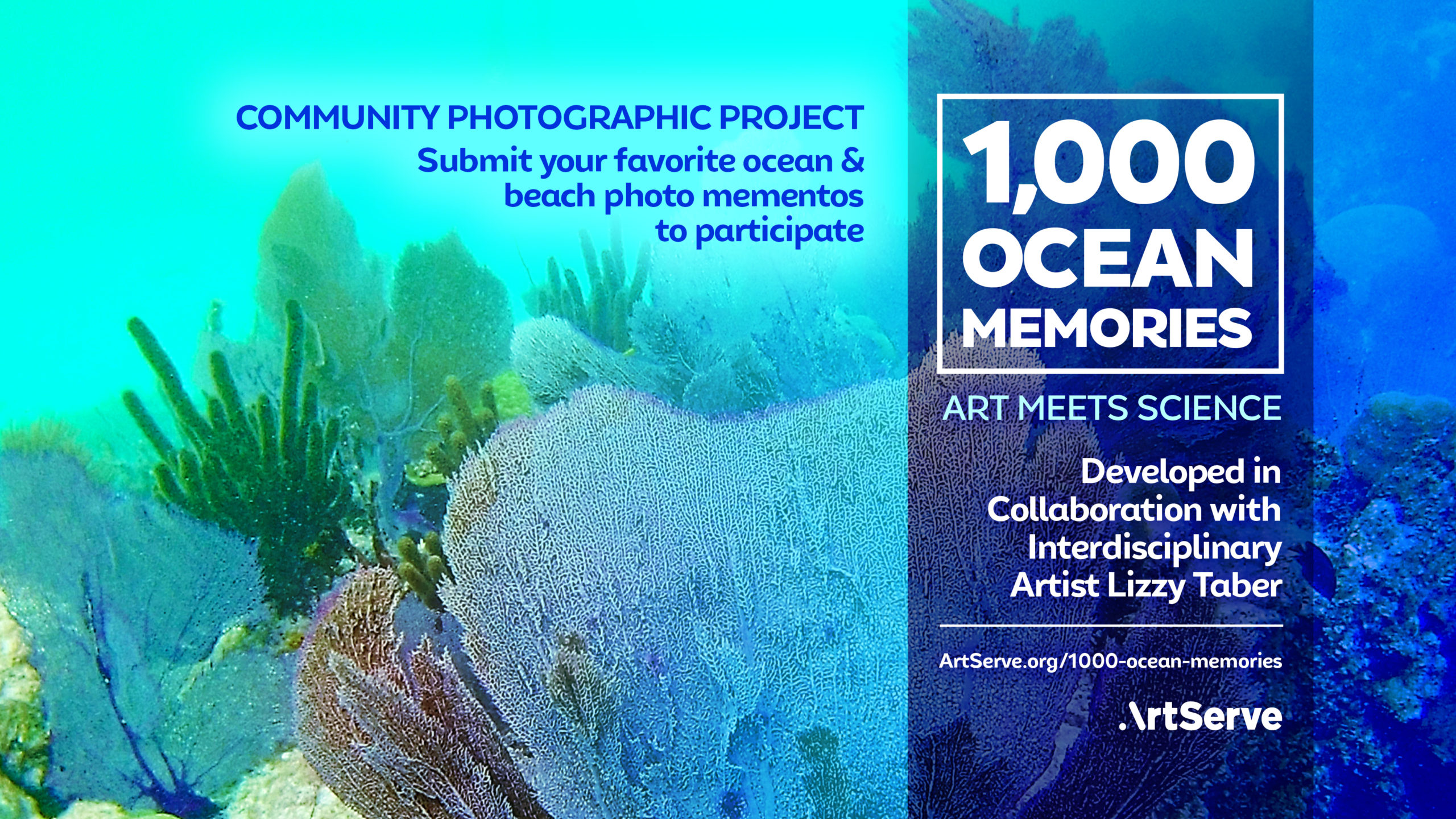
“My stories are told without words, so you can listen with your eyes.”
This explains my creative process: tell the story on canvas, inviting the imagination to sense– a where, when or why. My work is representational, using oil painting impasto with a palette knife to emphasize textures, experimenting with color and contrast, resulting in a distinct character.
“ Save Our Seas ” is a series of oils on canvas I created in 2020, focusing on underwater life because that environment is quickly changing. With this series, I pay homage to our treasured coast, corals and ocean, in hopes to open a conversation about respect and awareness.
These underwater seascapes created with vibrant, intense colors and textures, could be a thing of the past if we don’t take action, since coral reefs are rapidly bleaching and dying from pollution and climate change. As the links of a weak chain, when the reefs suffer, so do all other resources from our oceans and seas.
I have pledged this series to Ocean Conservancies. At this time one piece is being exhibited at the Florida Capitol in Tallahassee, Department of Agriculture and Consumer Services, and two pieces were already sold, with 100% of the proceeds benefiting Ocean Conservancies.
I intend to donate 100% of MY proceeds resulting from the sale of the series “ Save Our Seas ”, to benefit Ocean Conservancies.
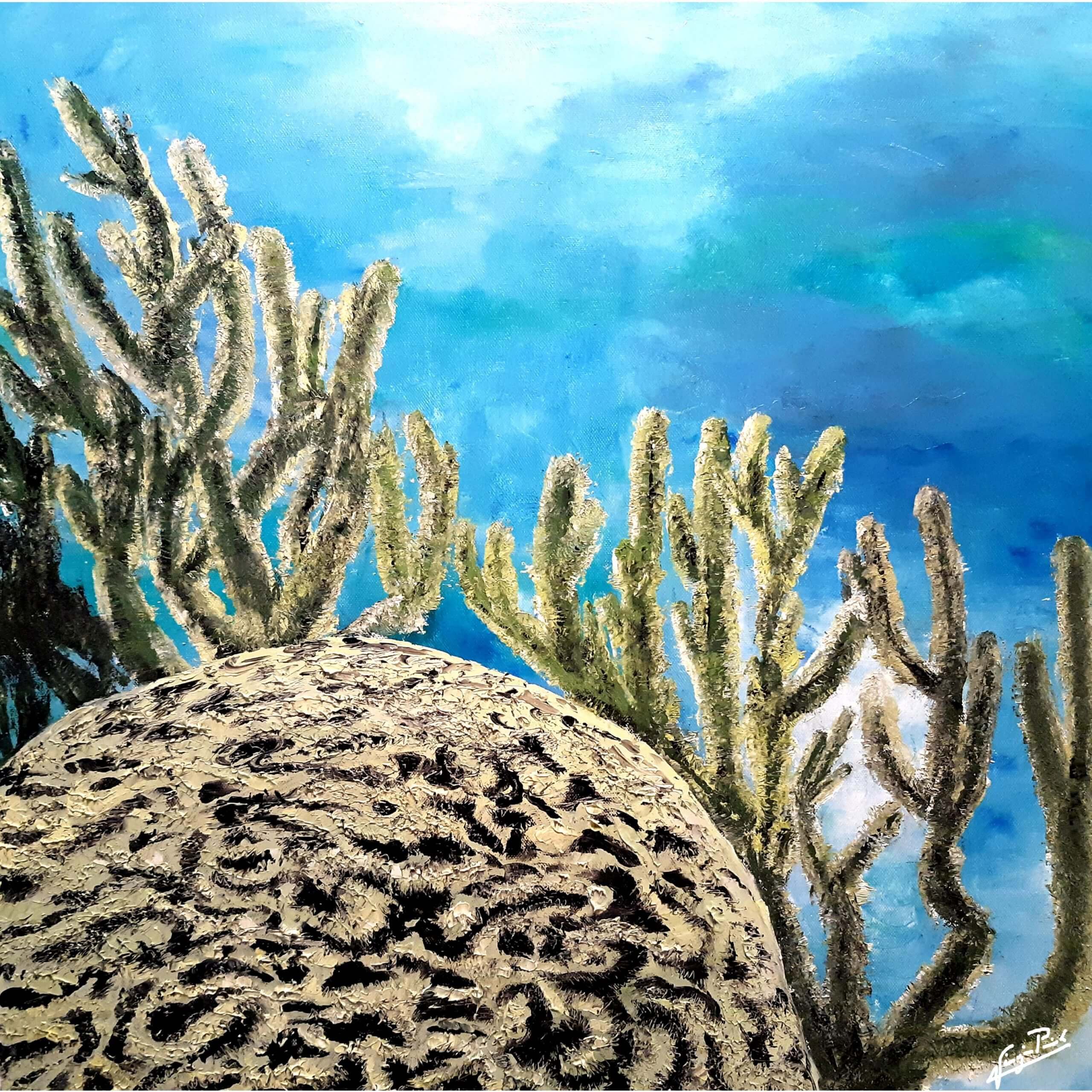
GMO- (Genetically Modified Objects) – An Environmental Radiographic View
“These radiographic(x-ray) views of natural and artificial objects set the foundation for my use of the word GMO (genetically modified object) as a metaphor. Some of these images have been digitally modified to raise the questions of our changing environment and the heavy-handed interference of humans on nature. Some objects have been placed together artistically to create either a new narrative or to show the beauty and complexity of nature.”
Twyla’s manipulated digital radiograph (x-ray) series is an Art/Science collaboration. These images were taken on a mammogram machine in cooperation with Dr. Robert Gould and the University of California-San Francisco Medical Center.
Radiography explodes the usual, the “normal” representations and looks deep inside our natural world. It is more than a technique- it is the only possible “means” to read reality, through matter rather than light. A blueprint.
The process creates images that explore the inner structures and show the fragile, sometimes surprising, aspects of objects and plants. Radiography exposes the biological structure of both nature and man-made items.
Does it alter our perception or preconceptions?
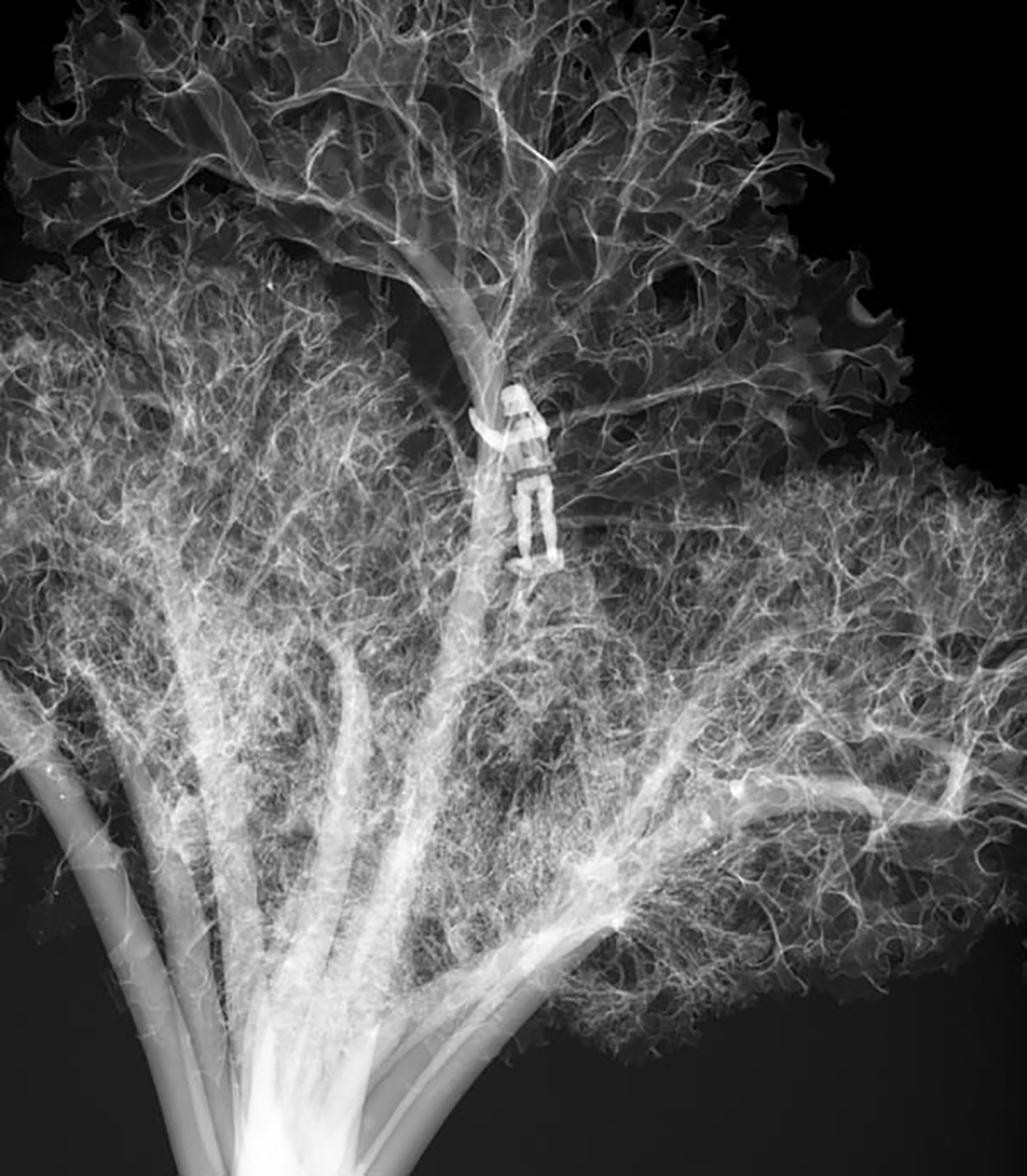
Disappearing Hemlock
Golden sun rays pass through the forest mixing with the warm scents of fall, allspice, cinnamon, and lemon, belying the massive destruction all around.
Forests throughout the Smokies are undergoing a major ecological shift due to the die-off of millions of hemlocks caused by the hemlock woolly adelgid. This nonnative forest insect pest is believed to have come to the United States in the early 1900s from Japan, transported over by humans.
First discovered in the park in 2002, humans continue to spread the insects through firewood. Forestry experts say their loss will affect everything from stream temperatures to forest composition. Although hemlocks can live up to 600 years, a woolly adelgid can kill a tree in just three to 10 years.
